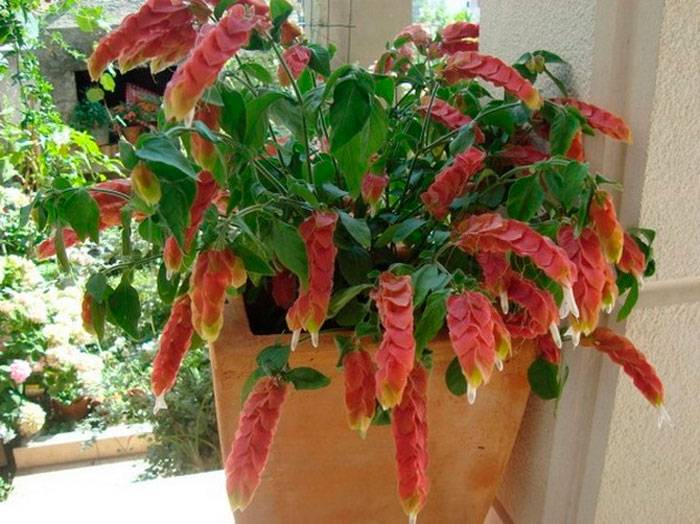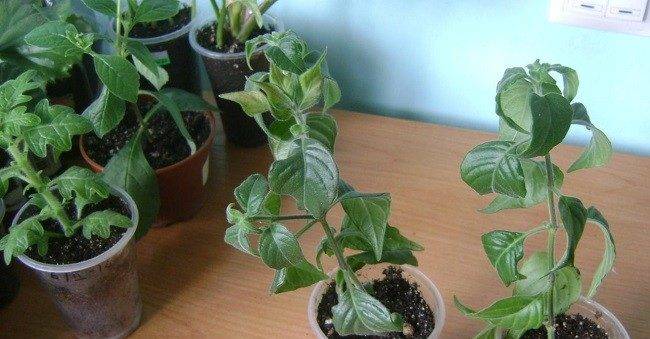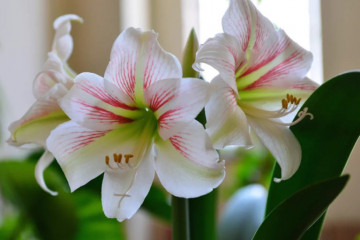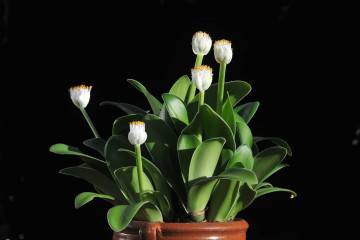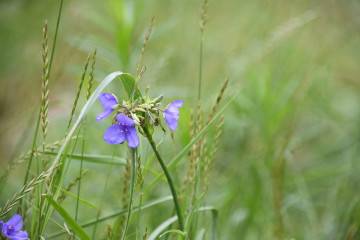Beloperone - home care
Content:
Beloperone is an exotic plant. It attracts attention with its bright large inflorescences, long flowering period. For beloperone, home care is easy to do, but there are some peculiarities when growing.
Flower appearance
Beloperone is a plant from Latin America. Belongs to the Acanthus family of the genus Justice. Another name for the plant is Jacobinia. The shrub has drooping oval leaves and stems. White flowers form a single spike. They are covered with bracts, which delight the eye with bright colors - red, yellow and orange. The first shade is most often found.
In its natural environment, an evergreen dwarf shrub can grow up to 1.5 m. Growth is quite fast. Blooms for a long time - up to 10 months.
Common varieties
In Latin America, the white perone has 60 varieties. Several of them can be grown at home:
- drip whiteperone (Brandeg's justice). The most common variety for the home. The homeland of the shrub is Mexico. Large red inflorescences are lowered down. The length of the bush is 20 cm. The semi-shrub can grow up to 1 m. Strongly branched;
- drip variegated beloperone. Bred by selection. The height of the bush is 70-80 cm. It gives a lot of flowers. The bracts have a bright burgundy color, which is slightly muted. Leaves beloperone variegated not of a uniform color, but composed of shades of green. The mosaic pattern disappears if the bush is in a dark room;
- whiteperone drip purple. Selective type of bush 70-80 cm high. Branched stems are directed downward. The bracts are colored red, lilac. Prized for flowering all year round.
All varieties of beloperone are able to decorate the house thanks to their bright colors.
Features of home care
Caring for the beloperone is simple. To achieve a bright flowering, you need to create comfortable conditions for the existence of a house.
Temperature
The beloperone flower was brought from South America. Therefore, he prefers warmth. In spring and summer, the temperature should be kept at least 20 ° С, in the cold period - up to 16 ° С. At temperatures below 13 ° C, the shrub can die.
Lighting
A plant needs a lot of light. The bright sun does not harm the flower in the early morning and evening, but during the day the lighting should be diffused. The location of the beloperone is preferable on the east or west window. In order for the light to hit all parts of the plant, it must sometimes be turned in different directions to the sun. With a lack of light, the bracts fade. For the appearance of flowers in the cold period in winter, fluorescent lighting or phytolamp is used.
Watering
For beloperone, watering should be moderate when leaving. More water is required in spring and summer than in autumn and winter. The abundance of fluid harms the beloperone, causing various diseases. Therefore, you need to ensure that moisture does not remain in the pan. It is worth watering if the ground is dry. The water should be separated and at room temperature.
Spraying
The flower needs daily spraying of the leaves with warm water. On a hot day, this should be done several times a day. Spraying helps to maintain the desired humidity, protects against insects. Another option is to wipe the bush with a damp soft sponge.
Humidity
The plant prefers moderate indoor humidity up to 80%. To maintain it, you can put wet pebbles, expanded clay, peat in the pallet. Sphagnum moss also retains moisture well. A special humidifier for the home will help to increase it.
Priming
The land where the shrub is planted should be light, and the acidity neutral. A slightly acidic version is suitable. For planting, you need a leafy, turfy part of the soil, to which sand, humus, peat are added. The proportions are 2: 1: 1: 1. Bone meal is placed in the earthen mixture. Chalk will also work.
Top dressing
For good flowering, the plant needs a mineral supplement with magnesium or potassium, it is especially important during active growth - from May to September-October. Fertilizer should be used once every 2 weeks. In the winter period of rest, top dressing is applied once a month.
Features of winter care during the rest period
The dormant period of evergreen beloperone begins with the arrival of cold weather, but it is not as pronounced as in other flowers. The leaves of the bush do not fall off. During this period, growth will slow down, flowering stops until spring.
In winter, you should slightly change the care of the flower: lower the temperature to 16 ° C, reduce the frequency of watering. The plant needs to be illuminated in the dark. In winter, growth slows down, so there is no need for frequent feeding, only once a month.
After the end of the dormant period, it is necessary to increase the temperature, the frequency of watering and feeding, caring for the flower in the usual way.
When and how it blooms
A distinctive feature of most species of beloperone is that the shrub blooms annually for a long time (up to 10 months). Flowering is most active in spring and summer when it grows. During the dormant period in winter, the flowers tend to fall off, but the bush does not look bare due to the large number of green leaves.
Beloperone blooms brightly. Many inflorescences appear on the bush at once. They originate at the base of the leaves and form a single line. Small white flowers hide behind large red bracts 14-16 cm long. Flowers behind them are difficult to see.
Pruning
Beloperone is a plant with fast growth, developed branching, so it needs to be cut frequently, and wilted flowers should be removed. The procedure is carried out in the spring. The shoots are shortened by 1/3. As a result, branching becomes neater, more inflorescences are formed, since energy is expended on flowering, and not on growing shoots and leaves.
The shape of the crown of the beloperone can be formed independently. A plant pruner is used for pruning. It does not injure shoots. To increase the number of shoots, pinch the bush. After the procedure, top dressing is needed. Cut shoots can be used to grow new plants.
How whiteperone reproduces
For breeding a new white perone bush, care and reproduction take the main place in the growing process. Increasing the flower population is possible with:
- seeds;
- cuttings.
Reproduction of flowers is easy to carry out on your own, the process does not take much time.
Germinating seeds
The best time to plant seeds is in March. First, the cultivation process takes place in the ground, consisting of a mixture of leafy soil and sand. In order for the seeds to sprout, high humidity and temperatures up to 25 ° C are required.
The seedlings are transplanted into small pots with a substrate consisting of a mixture of leafy, turfy soil and sand. The ends of the branches should be pinched to stimulate branching.
Breeding by cuttings
This breeding method is simpler than the previous one. Cuttings are obtained by pruning the shoots of the plant in the spring. A suitable size is 10 cm. When planting on cuttings, small leaves should remain.
When planting cuttings in the ground, it is important to moisten the ground and treat the shoots with a biostimulant. To create the desired microclimate at 25 ° C, they are covered with a plastic cup or bag.
Cuttings sometimes need to be opened and sprayed with water. After 8-10 days, roots appear. After the final rooting, the plants are transplanted into separate pots, the ends are pinched.
Transfer
The indoor flower beloperone has fast growth. It is necessary to transplant at the moment when the roots have filled the space of the entire pot and began to look out from the lower holes. It is necessary to transplant a young bush every year or 2 times - in spring and summer during the most active period of its growth. For a large plant placed in a weighty pot, it is enough to carry out the procedure once every 2 years.
Diseases and pests
Whiteperone indoor plants do not have a predisposition to diseases, but they can be attacked by pests. Insects feed on the sap of the bush.
Dangerous species for a flower are:
- aphid. A green or black insect that clings to the leaves and stems of the bush. It multiplies quickly. The damaged areas of the flower curl. When exposed to pests, the plant may die. Soapy water, pungent herbs and chemicals help against aphids;
- whitefly. Small white butterflies sit on the bush, sticking around and damaging it. Insects are similar to moths. Vacuum cleaner, sticky fly tape, fumigator and chemicals are helpful for pest control;
- spider mite. Most often found on indoor plants. You can recognize the pest by the cobwebs on the shoots, leaves and yellow spots on the back. After a while, they begin to fall off. Alcohol tincture, which is then washed off, regular spraying with water or soap-based solution, chemicals, help to eliminate ticks;
- mealybug. Leaves white lumps and bloom at the base of the shoots, on the leaves. It can cover the entire area of the flower with them, which will greatly harm it. Soap solution and chemicals are used to combat the pest;
- shield. It manifests itself as growths on leaves and branches. It spreads quickly through the bush. The affected area becomes yellow or reddish. The blackness of the earth is intensified. Insects have a strong shell, so it is quite difficult to remove them. Vinegar, turpentine can help, which after a few hours needs to be washed off with water along with insects. Another option is specialty chemicals for plants;
- enchitreus. Long worms can grow in a whiteperone flower. They look white up to 4 cm in length. They live in the ground between the roots of the flower. Plant in the soil due to its waterlogging. They feed on dead plant tissues. The growth of the bush slows down, the leaves turn yellow. To get rid of insects, you need to place the pot in water, then the worms will float. After that, the flower should be transplanted.
It is necessary to eliminate pests on time so that they do not have time to spread throughout the plant and destroy it.
Beloperone is a beautiful plant with large inflorescences of an unusual shape and flowering up to 10 months. When buying a shrub, you need to decide on the type of beloperone and study the features of care so that it is comfortable in the house.
